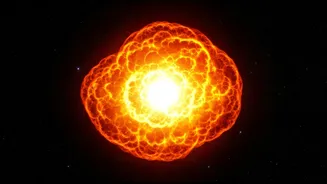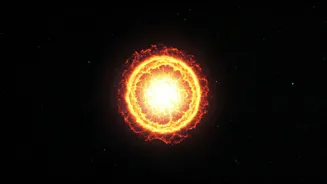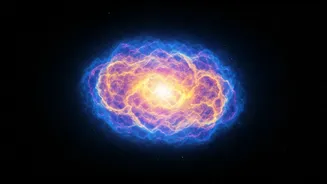Supernova Unveiled
The recent observations have provided a fresh perspective on supernova explosions. The detailed analysis revealed an asymmetric blast, deviating from previous
theoretical models. Supernovae are the explosive ends of massive stars, playing a pivotal role in the universe. They scatter heavy elements into space, which are essential for forming new stars and planets. The recent study focused on a Type II supernova. The team used advanced telescopes to observe the light emitted during the initial stages of the explosion, and it revealed a complex, olive-shaped structure. This asymmetry challenges conventional understanding, suggesting that the explosion mechanisms may be more complex than previously thought. The study, therefore, offers a critical starting point to understanding the nature of these events.
Asymmetric Explosion's Shape
The research, a collaboration of multiple teams, utilized powerful telescopes to analyze the light emitted from the supernova. The early data showed that the explosion was not spherical, but shaped more like an olive. This asymmetry suggests that the core collapse process and the subsequent shockwave are not uniform. The irregularities could be linked to various factors. These include the star's rotation, magnetic fields, and the complex interplay of nuclear reactions within the core. The findings have profound implications for understanding how heavy elements are distributed in space. The uneven explosion could influence the distribution of these elements, affecting the composition of future stars and planetary systems. This discovery urges scientists to rethink and refine existing supernova models.
Insights into Stellar Death
The early observations have provided invaluable data on the inner workings of supernovae. The study of the supernova gives researchers a chance to understand the intricate processes that happen during a star's final moments. These events begin with the core collapse of a massive star, which triggers a powerful explosion, expelling the star's outer layers. The core, however, can either become a neutron star or a black hole, depending on its initial mass. Analyzing the light from the supernova allows astronomers to study the shockwave's propagation and the creation of elements like oxygen, silicon, and iron. This research helps refine models of stellar evolution and element formation, enriching our knowledge of the universe. The study reinforces the importance of using multi-faceted observation techniques.
Impact on Astrophysics
This discovery offers new insights into how stars end their lives. The detailed examination of the early moments of the supernova explosion offers a fresh understanding of the physics driving stellar evolution. The data from these observations helps scientists refine models of supernova explosions, which in turn leads to a deeper grasp of how elements are formed in the cosmos. These elements are essential for the development of new stars, planets, and even life itself. The asymmetrical explosion, as observed, urges astronomers to re-evaluate their theories of the explosion and the star's final moments. It encourages the development of more advanced models that can incorporate the complexity found in real supernovae.












